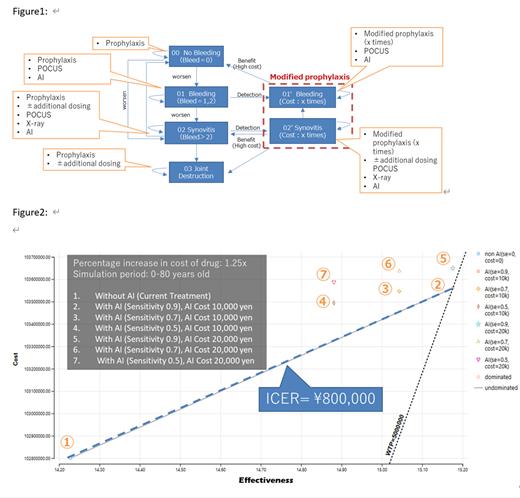Background: In previous studies, we reported that regular semi-annual POCUS over three years led to modifications in prophylaxis, contributing to the disappearance of synovitis, improvement in the annual bleeding rate, and joint function in hemophilia patients. Most modifications involved increasing doses, shortening intervals, and changing to new drugs. With ongoing AI technology development to offer accurate POCUS delivery, often dubbed as provider-dependent, we foresee active modifications of prophylaxis in clinical settings as AI-enabled ultrasound becomes prevalent. Such interventions could improve patient joint prognosis through early synovitis treatment but may also lead to increased consumption of therapeutic drugs.
Objective: To compare the ‘improvement in prognosis’ with ‘increased costs’ from a health economic perspective, primarily from an insurer's viewpoint.
Method: Patient states were defined to create a state transition model as follows:
No bleeding: Normal state with no bleeding or synovitis.
Bleeding present: State of having 1-2 bleeding episodes in six months.
Synovitis: Chronic bleeding-prone state due to synovitis. This state worsens at a certain rate, necessitating modification of regular replacement therapy.
Joint destruction: An irreversible state of terminal arthritis where the cartilage and bone are destroyed.
Death: Regardless of the association with hemophilia.
Transition probabilities were set based on prior studies, and the state transition model is depicted in Figure 1. We assumed all patients were receiving regular replacement therapy. We obtained the distribution of age, compliance rate, and the number of intra-articular bleedings from the transition model and optimized the transition probabilities to minimize the difference between the obtained distribution and the distribution from prior studies. The treatment cost for each state was referenced from the standard cost ascertainable in Japan.
The model assumes the perfect sensitivity of the AI technology in identifying patients who require modifications in their therapy. We also assume that there would be no false negatives when a physician's judgement is involved, and the model does not consider the AI's specificity. In the scenario where a physician disagrees with the AI's judgement, we assume that the physician would maintain their decision.
Results: The comparison of Incremental cost-effectiveness ratio (ICER) with or without POCUS, when the post-therapeutic modification drug cost increases by 1.25 times, is shown in Figure 2. With the cost increase at 1.25 times, the ICER is below 5 million yen, a threshold value suggested by guidelines that indicates superior cost-effectiveness. However, if the cost increase is twofold, the ICER becomes 6.04 million yen, indicating poorer cost-effectiveness with POCUS. The result implies that diagnostic AI-POCUS proves superior in terms of cost-effectiveness when the ‘cost increase ratio’ is below or equal to 1.85. In evaluating the cost-effectiveness of POCUS, the ‘drug cost increase ratio’ was a significant factor influencing ICER, while the costs, sensitivity, and specificity of POCUS had a smaller impact.
Limitation: Our model assumes the ‘additional cost is uniformly fixed for all patients’, which may not reflect the reality of clinical practice. Additionally, we have not considered the possible clinical benefits and quality of life improvements that can occur regardless of the cost implications.
Conclusion: This preliminary study suggests that AI-aided POCUS is cost-effective compared to regular POCUS management in treating early-stage joint damage in hemophilia patients when the increase in medication costs remains below a 1.85 multiplier, from an insurer's perspective. The study focuses on the improvement of underdiagnoses by evaluators through AI technology. Further studies are required to refine these estimates, validate our model in a real-world clinical setting, and to fully understand the sensitivity and specificity of the AI system.
Figure1: The transition model of patients states
Figure2: Incremental Cost-Effectiveness Ratio with and without AI-POCUS in Response to a 1.25 Fold Increase in Post-Therapeutic Modification Drug Cost
Disclosures
Nagao:Sanofi K.K., Takeda, Chugai Pharmaceutical Co., Ltd., Bayer Holding Ltd., Fujimoto Pharmaceutical Corporation, KM Biologics, Pfizer Japan Inc., Japan Blood Products Organization, Novo Nordisk, Sekisui Medical Co., Ltd., CSL Behring: Honoraria; Takeda: Consultancy; Bayer Holding Ltd., Takeda, Chugai Pharmaceutical Co., Ltd for non- related study: Research Funding. Kido:Hitachi, Ltd.: Current Employment. Nakamoto:Hitachi, Ltd.: Current Employment. Yoshida:Hitachi, Ltd.: Current Employment. Fukutake:CellGenTech, Inc: Consultancy; KYORIN Pharmaceutical. Co., Ltd.: Consultancy; Chugai Pharmaceutical Co., Ltd: Consultancy, Honoraria, Speakers Bureau; Bayer Yakuhin, Ltd.: Honoraria, Speakers Bureau; Sekisui Medical Co., Ltd.: Honoraria, Speakers Bureau; Novo Nordisk Pharmaceuticals Ltd.: Honoraria, Speakers Bureau; Takeda Pharmaceutical Co., Ltd.: Honoraria, Speakers Bureau; KM Biologics Co., Ltd.,: Honoraria, Speakers Bureau; Japan Blood Products Organization: Honoraria, Speakers Bureau; Pfizer Inc.: Honoraria, Speakers Bureau; CSL Behring: Honoraria, Speakers Bureau; Sanofi K.K.: Honoraria, Speakers Bureau; Asahi Kasei Pharma Corporation: Honoraria, Speakers Bureau; Fujimoto Pharmaceutical Corporation: Honoraria, Speakers Bureau.


This feature is available to Subscribers Only
Sign In or Create an Account Close Modal